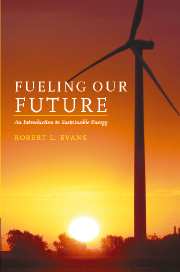Book contents
- Frontmatter
- Contents
- Preface
- Acknowledgments
- Glossary
- Part I Setting the scene
- Part II The global energy demand and supply balance
- Part III New and sustainable energy sources
- 6 Non-conventional fossil fuels
- 7 Renewable energy sources
- 8 Nuclear power
- Part IV Towards a sustainable energy balance
- Index
- References
8 - Nuclear power
Published online by Cambridge University Press: 05 June 2012
- Frontmatter
- Contents
- Preface
- Acknowledgments
- Glossary
- Part I Setting the scene
- Part II The global energy demand and supply balance
- Part III New and sustainable energy sources
- 6 Non-conventional fossil fuels
- 7 Renewable energy sources
- 8 Nuclear power
- Part IV Towards a sustainable energy balance
- Index
- References
Summary
INTRODUCTION
The inclusion of nuclear power in a section on “New and sustainable energy sources” may seem controversial to some readers. However, nuclear energy is today an important primary energy source which produces no greenhouse gas emissions while generating electricity. In fact, in some countries nuclear power provides a significant share of electrical power generation, and accounts for nearly 80% of all electrical power production in France, for example. Nuclear power was originally developed in the 1950s for the peaceful application of the very large quantities of energy released by the splitting of atoms, or “nuclear fission,” and by 2001 it accounted for 17% of all electricity produced worldwide. The very first nuclear station to generate electricity began operation in Russia in 1954, with a capacity of just 5 MWe. The first commercial-scale nuclear powerplant, however, was the Calder Hall station, opened in the UK in 1956, consisting of four reactors each with an electrical generating capacity of 50 MWe. During the early years of nuclear power development it seemed that this source would provide an inexhaustible source of low-cost electricity, and it was pursued aggressively in much of the developed world. After considerable expansion through the 1960s and 1970s, significant cost overruns and two serious nuclear power accidents in the 1980s brought about a change in the public perception of the safety, security, and cost of nuclear power. This resulted in a dramatic reduction in the construction of new plants in most parts of the world.
- Type
- Chapter
- Information
- Fueling Our Future: An Introduction to Sustainable Energy , pp. 115 - 138Publisher: Cambridge University PressPrint publication year: 2007



